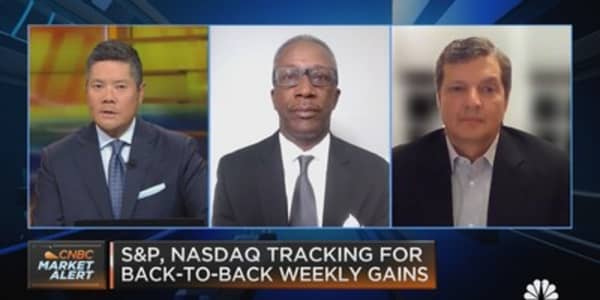If you're one of the few workers still covered by a pension, consider yourself lucky — very lucky. Pensions, once a standard fixture of corporate America, are about as rare as a climate-change believer in the incoming Trump administration.
According to the Bureau of Labor Statistics, just 20 percent of the private-sector workers can rely on a pension to fund their retirements. But in 1980, 38 percent of private-sector workers were covered by a pension. Public-sector workers have better access to pensions, but over the years they've had to contribute more of their own money to their pensions.
Why are pensions so rare? Simple, said Michael Baker, a certified financial planner with Vertex Capital Advisors. "They're expensive."
Pensions bind employees to companies long after they have retired, staying on their balance sheets as liabilities. Increasing longevity has kept companies on the hook longer still. And today's low interest rates don't help, either. Plans have had to accept lower investment return and been forced to shore up their plans with cash.
Pensions, where they still exist, are mostly confined to old-line companies, said Jean-Pierre Aubry, associate director of state and local research with the Center for Retirement Research.
"It's not so much that old companies closed their pensions, but as old companies went bankrupt, those pensions went away," Aubry explained. "The new firms that have been started in the last 40 years were not starting defined benefit plans."
If you are one of the few who still has a pension, there's a lot to consider before you collect. Pension plans are complicated, and they come in many different forms.
"Plans can be so complex, and no one likes to read the plan documents," said Rose Swanger, principal of Advise Finance. "If you don't read them, you can miss the most important part."
Lump sum or annuity?
The first thing to figure out is how you'll receive your money. There are two options: a lump sum or a monthly payment, essentially an annuity. Remember that whichever method you choose is set in stone. There are no do-overs.
Companies would prefer you take the lump sum because it will get you off their books. They pay you one big amount now. But by committing to an annuity, they're on the hook for years or decades.
"The annuity almost always makes more sense," said Iain Reilly, a CFP with Telesis Financial. "The problem with the lump sum is that it has to be reinvested. And at such low interest rates, it's very difficult to justify."
You might be offered $250,000 as a lump sum when you retire. At age 65, if you were to buy an immediate annuity, you are likely to receive a payment of $1,200 to $1,300. The annuity you can receive from your company will most likely be significantly higher.
More from FA Playbook:
Advisor calms clients after Trump win
6 ways Trump will affect your wallet
The potential market impact of Donald Trump in the White House
But there are times when the lump sum makes sense.
"We have clients who may not need the money, so the lump sum might make a nice legacy for children," said Michael Fuhr, CFP and chief operating officer of SageVest Wealth Management.
Swanger of Advise Finance, meanwhile, believes that a lump sum can be used to pay off an existing mortgage to free up cash in retirement. In addition, retirees in poor health who do not have a long life expectancy may do better by opting for the lump sum.
You must also decide whether your pension will cover just you or your spouse, as well.
Single life or joint?
There are several options to consider. A single life annuity offers the highest monthly benefit. That's a no-brainer for someone who is single. But married people may have a more complicated calculation.
"If there's a big age difference between the spouses, then a joint pension might be better," said Rita Mansour, a CFP and partner with McDonald Partners.
Some pension plans will allow you to sign on for a lower payment that will then transfer to your spouse at your death. Another option may be for a higher initial benefit (though not as high as the single life payment), but then a 50 percent payout for your spouse if you die first.
Robert Reby, founder of Reby Advisors, thinks retirees could make out better by self-insuring. Reby's office in Danbury, Connecticut, counts among its clients many employees of nearby IBM, which still has a pension, though it has been closed to new participants since 2008.
Depending on their health, Reby has advised some clients to take the single-life benefit but then purchase a life insurance plan that would provide their surviving spouse with the same payout. This is worth doing only if life insurance premiums cost less than the difference between the higher payout for the single-life annuity versus the lower amount of the joint annuity, he said.
Ongoing monitoring
If you elect the annuity payment, your job is by no means done. You must keep a watchful eye on your former employer for signs of financial stress and any possibility that your pension payout could be in jeopardy.
Retirees of several multiemployer plans are facing this possibility. These plans, which are established by unions for the benefit of workers in the same industry but in different companies, are facing funding shortfalls. Thanks to the Multiemployer Pension Reform Act of 2014, trustees of multiemployer plans may be able to cut benefits for current retirees.
It's important to pay attention to how well funded the pension plan is, said Advise Finance's Swanger. "A plan that's less than 80 percent funded should be a red flag," she said.
If your company does go bankrupt, your pension is most likely safe. Firms pay premiums to the Pension Benefit Guaranty Corp. to insure their pensions. That entity will step in and pick up the tab for pensions up to $60,136 a year at age 65.
"For the majority of people, that should suffice," said Fuhr of SageVest Wealth Management.
— By Ilana Polyak, special to CNBC.com




